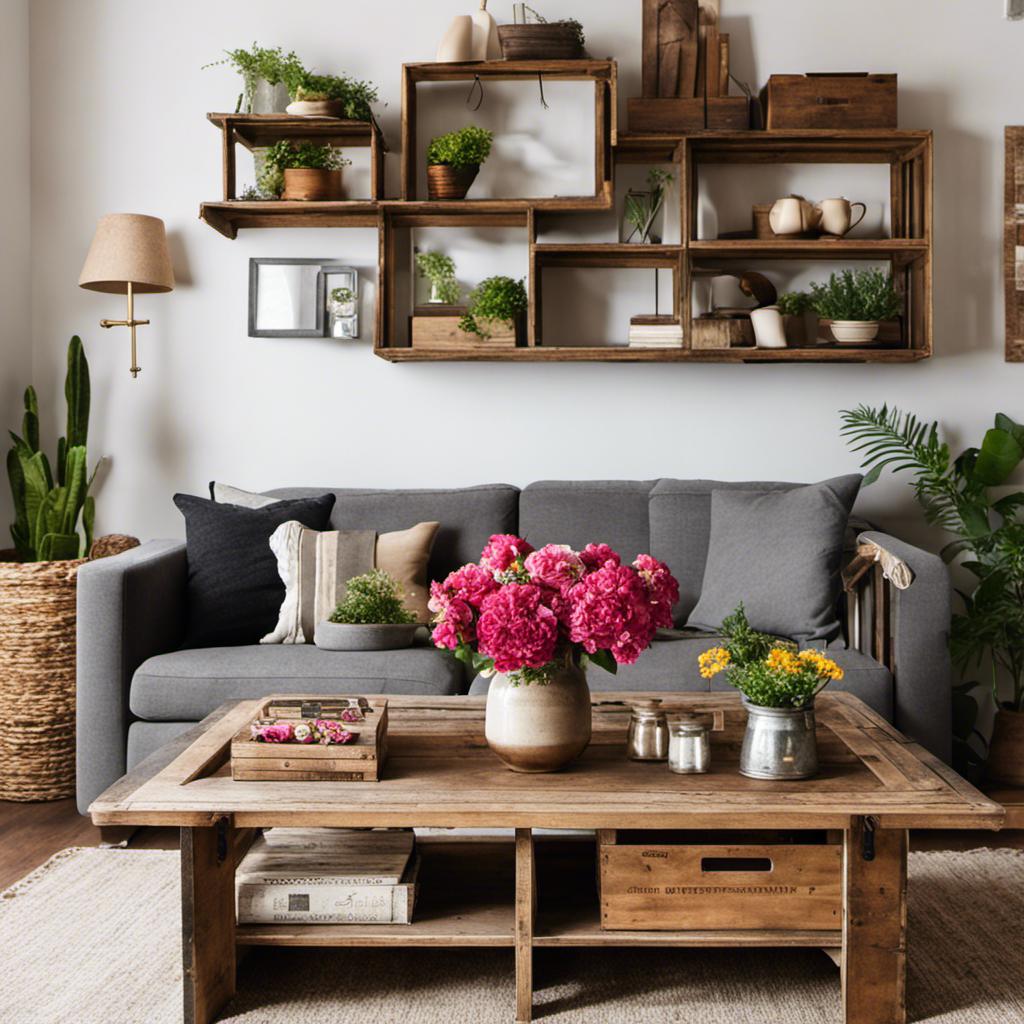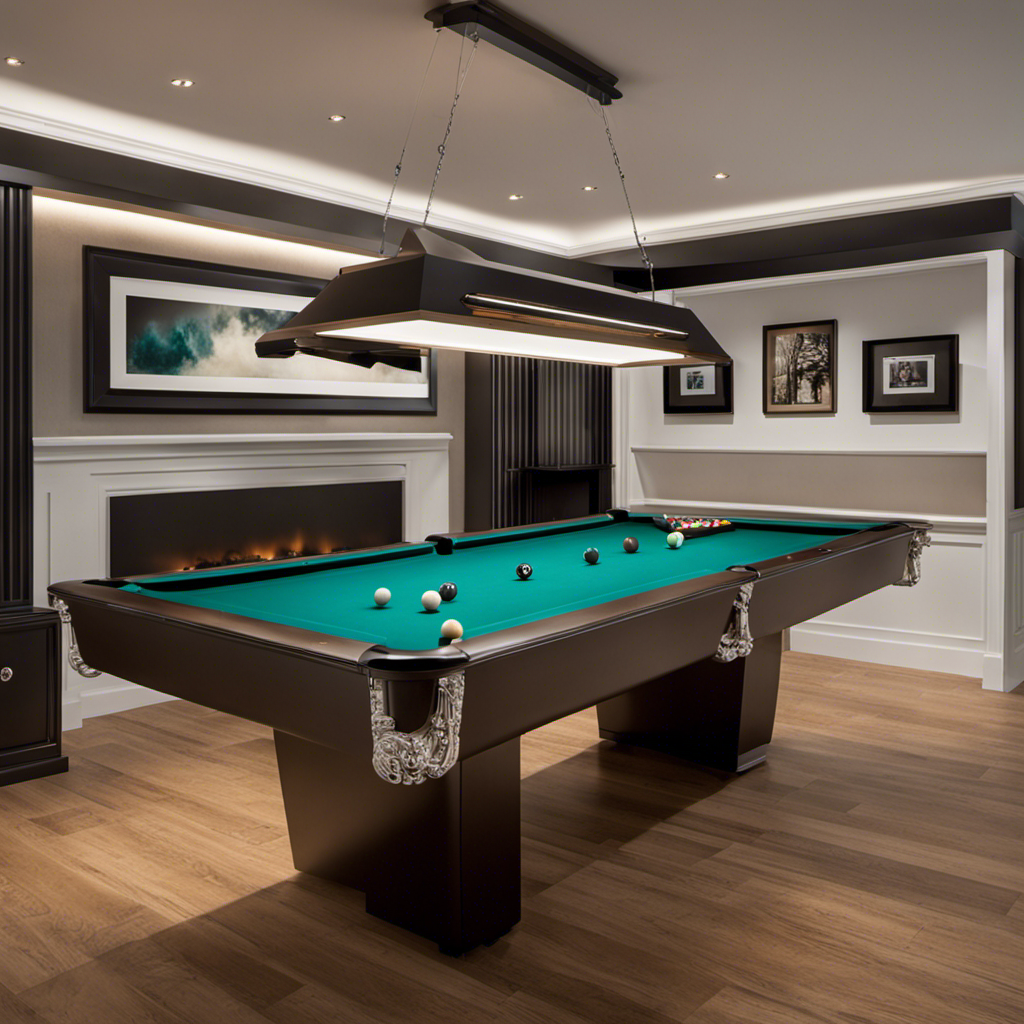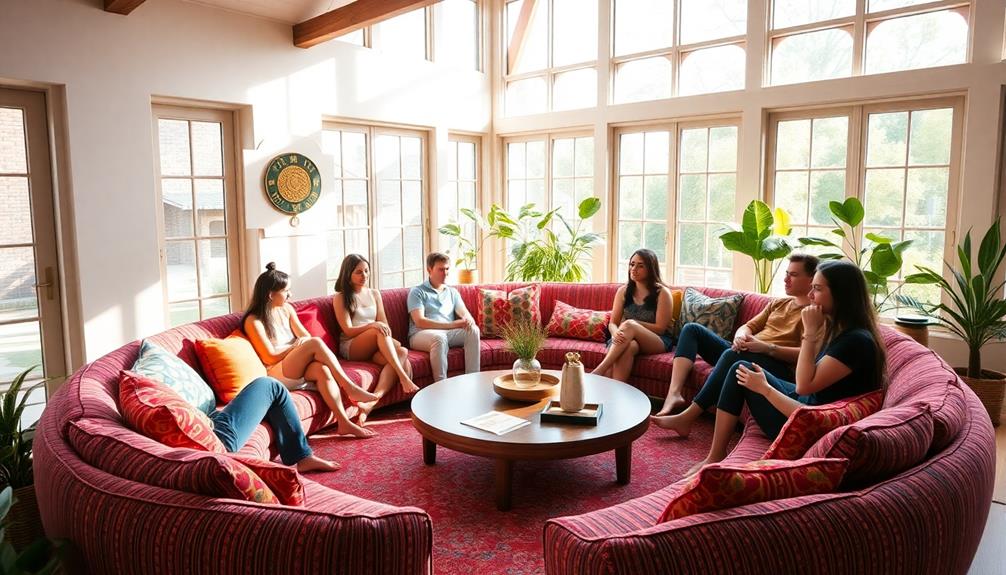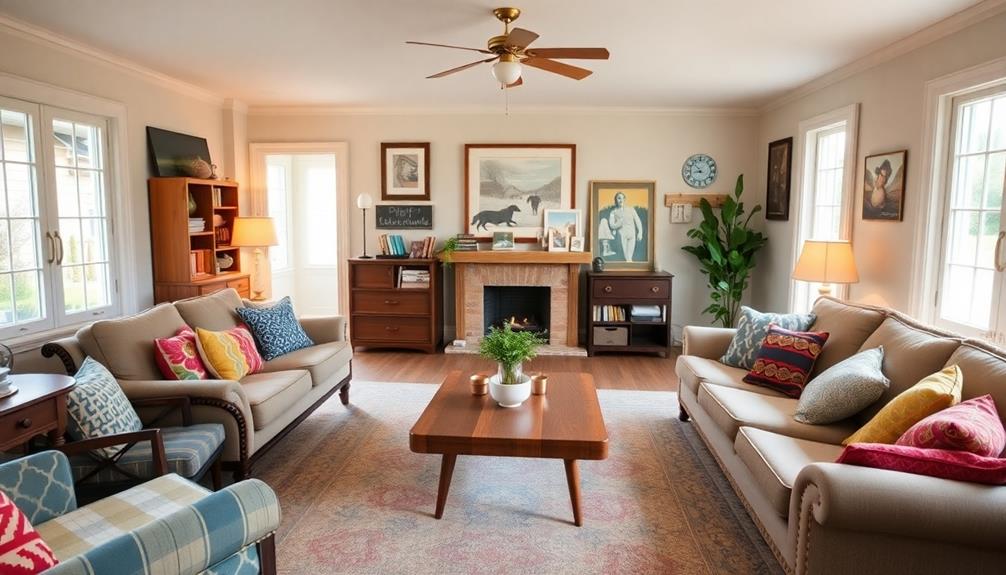Decor
How to Decor With Crates

As a lover of unique and creative home decor, I have always been drawn to the charm and versatility of crates. These humble wooden structures hold endless possibilities for adding a touch of rustic elegance to any space.
In this article, I will guide you through the art of decorating with crates, from choosing the perfect ones to creating DIY furniture and stylish storage solutions.
Get ready to elevate your interior design game with these ingenious crate decor ideas.
Key Takeaways
- Consider size, material, and design when choosing crates for decor.
- Repurpose wooden crates for sustainable and creative furniture pieces.
- Style crates for shelves to add creativity and organization to your home.
- Use vintage crates to creatively display plants.
Choosing the Right Crates
To choose the right crates for your decor, you’ll want to consider their size, material, and design.
When it comes to decorating with vintage crates or repurposing wooden crates, it’s important to find ones that not only fit your style but also serve a practical purpose.
Vintage crates add a rustic charm to any space and can be used as storage or display units. Look for crates made of solid wood for durability and authenticity.
Consider the size of the crates to ensure they fit in your desired space and can hold the items you want to store or display.
Lastly, pay attention to the design of the crates, such as the color, finish, and any unique features they may have, as this can enhance the overall aesthetic of your decor.
DIY Crate Furniture Ideas
There are endless possibilities for creating unique and stylish furniture pieces using crates. Repurposing wooden crates is not only a sustainable option but also allows you to add a touch of creativity to your home decor. One popular idea is to use crates for shelving. By stacking crates vertically or horizontally, you can create functional and visually appealing storage solutions. Additionally, crates can be transformed into coffee tables, side tables, or even bookshelves. The versatility of crates allows you to customize their appearance by painting them in different colors or adding decorative elements such as knobs or labels. Below is a table that showcases three different crate shelving ideas:
| Idea | Description | Image |
|---|---|---|
| Floating Shelves | Mount crates on the wall for a minimalist and space-saving look. |  |
| Modular Shelving | Arrange crates in a modular pattern to create a customizable storage system. |  |
| Ladder Shelf | Lean crates against a wall in a ladder-like fashion for a rustic and trendy display. |  |
With these crate shelving ideas, you can transform ordinary wooden crates into functional and stylish furniture pieces that suit your personal taste and home decor. Let your creativity run wild and enjoy the process of repurposing these versatile crates.
Styling Crates for Storage and Organization
Transforming wooden crates into stylish storage solutions can add a touch of creativity and organization to your home. Styling crates for shelves is a fun and versatile way to showcase your personal style while keeping your belongings tidy.
Vintage crates, with their rustic charm, are especially popular for organizing and decorating. When styling crates for shelves, it’s important to consider their size, shape, and color. Group crates of different sizes together to create visual interest and varying levels of storage. You can also paint or stain the crates to match your existing decor or create a contrasting pop of color.
Utilize the crates to store books, magazines, or even display plants and decorative items. The possibilities are endless when it comes to organizing with vintage crates, so let your imagination run wild!
Creative Ways to Display Plants With Crates
When styling with vintage crates, you can use them creatively to showcase and display your favorite plants. Not only do they add a rustic charm to your space, but they also provide a unique way to bring nature indoors. Here are four creative ideas to display your plants using vintage crates:
-
Hanging crate shelves: Attach ropes or chains to the crates and hang them from the ceiling or a sturdy beam. This creates a stunning floating shelf effect, allowing your plants to hang gracefully.
-
Crate planters: Line the crates with plastic or burlap to create a planter box. Fill them with soil and plant your favorite flowers or herbs. These crate planters can be placed on tables, windowsills, or even mounted on the wall.
-
Vertical crate garden: Stack the crates vertically and secure them together. Fill each crate with soil and plant different types of plants. This vertical garden creates a unique focal point and maximizes your space.
-
Crate wall display: Arrange the crates on the wall in an interesting pattern. You can use them as individual shelves to display small potted plants or create a cascading effect with trailing vines. This adds a touch of whimsy and turns your wall into a living art installation.
By incorporating these creative ideas, you can transform your vintage crates into stunning displays for your plants.
Now, let’s explore how to upcycle crates for unique wall decor.
Upcycling Crates for Unique Wall Decor
To create unique wall art, you can easily upcycle vintage crates into stylish and functional pieces.
Crate shelving is a fantastic way to repurpose these old crates and add character to any room.
First, find vintage crates that are in good condition and clean them thoroughly.
Next, decide on the layout of your crate shelving. You can stack the crates vertically or horizontally, depending on the space and aesthetic you want to achieve.
Secure the crates to the wall using brackets or screws, making sure they are level and sturdy.
Once the crates are securely mounted, you can use them to display books, plants, or other decorative items.
The rustic charm of the crates adds a unique touch to your wall decor, while also providing functional storage.
Frequently Asked Questions
How Do I Clean and Maintain Wooden Crates for Long-Term Use as Furniture or Storage?
To clean and maintain wooden crates for long-term use as furniture or storage, I follow these steps: first, wipe off any dust or dirt with a damp cloth. Then, use a mild detergent and water to gently scrub the surface. Finally, let it dry completely before applying a protective sealant.
Are There Any Safety Precautions or Tips to Keep in Mind When Using Crates as Furniture or Storage?
When using crates as furniture or storage, it’s important to consider proper weight distribution and ensure the stability of stacked crates for safety. These precautions will help prevent accidents and maintain the integrity of your decor.
Can I Paint or Stain Wooden Crates to Match My Existing Decor?
Can I transform wooden crates to match my decor? Yes! Get creative with painting techniques or explore alternative finishes like staining or distressing. It’s a fun way to add personality and customization to your space.
What Are Some Alternative Materials or Options for Crates if I Want a Different Look or Style?
For a different look or style, consider alternative materials for crates. Get creative with crate alternatives like vintage suitcases, wooden wine boxes, or repurposed wooden pallets. The possibilities are endless!
Are There Any Specific Tools or Materials Required for Upcycling Crates Into Unique Wall Decor Pieces?
For upcycling crates into unique wall decor, you’ll need tools like a drill, screws, and a measuring tape. Materials like paint or stain, sandpaper, and a sealant are also essential. Don’t forget safety precautions and proper cleaning and maintenance!
What Does Using Crates in Decor Say About a Person’s Style or Taste?
Using crates in decor says a lot about a person’s style or taste. Incorporating these versatile storage solutions into one’s design showcases a person’s interest in repurposing and creativity. The choice to utilize crates as decorative elements demonstrates a unique and resourceful approach to styling a space. It reflects an individual who values a blend of rustic charm and practicality in their person’s decor and their personality.
Can Crates be Used for Packing Decor When Moving?
When it comes to packing decor for moving, using crates can be a great solution. Not only do they provide protection for fragile items, but they also help keep everything organized during the moving process. Crates are sturdy and can be easily moved, making them ideal for transporting delicate decor items.
Conclusion
In conclusion, I must say that decorating with crates is truly a game-changer. Who knew that these humble wooden boxes could have such a profound impact on our homes?
From DIY furniture to stylish storage solutions, crates offer a world of possibilities. And let’s not forget about their potential to elevate our plant game and create unique wall decor.
So, if you’re looking to add some rustic charm and creativity to your space, don’t underestimate the power of crates. Embrace the crate revolution and let your imagination run wild!
- About the Author
- Latest Posts
Meet Katherine, the creative enthusiast at ByRetreat who infuses her boundless passion for design into every remote workspace she crafts. With an innate sense of creativity and an eye for unconventional beauty, Katherine brings a unique and inspiring perspective to the team.
Katherine’s love for design is infectious, and her ability to think outside the box sets her apart. She believes that true artistry lies in embracing a variety of styles and mixing them harmoniously to create captivating spaces. By combining different textures, colors, and patterns, Katherine weaves a tapestry of creativity that breathes life into each remote workspace.
Valentine's Day Decoration
Can Nurses Accept Chocolates From Patients?
As nurses, we frequently encounter situations where our professional boundaries blend with personal expressions of appreciation from our patients.
It's like walking a tightrope, trying to balance the warmth of human connection with the ethical considerations of healthcare.
Recently, a patient of mine presented me with a beautiful box of chocolates as a token of appreciation for the care I provided.
As I stood there, holding the gift in my hands, I couldn't help but wonder about the implications of accepting it.
This seemingly simple act raised complex questions about the impact on the patient-nurse relationship and potential conflicts of interest.
Join me as we explore the intricate web of considerations surrounding whether nurses can accept chocolates from their patients.
Key Takeaways
- Accepting gifts from patients, such as chocolates, can blur professional and personal boundaries for nurses.
- Nurses must carefully consider the ethical implications and potential impact on the therapeutic relationship before accepting gifts.
- Accepting gifts may create a sense of obligation, favoritism, or bias, compromising the integrity of patient care.
- Nurses should adhere to codes of conduct, policies, and legal guidelines regarding gift acceptance, considering institutional policies and state laws.
Professional Boundaries and Gift Acceptance
As nurses, we must carefully consider the implications of accepting gifts to maintain professional boundaries and uphold ethical standards.
Patient expectations of gift acceptance can sometimes create a dilemma for nurses. While it's natural for patients to want to show their gratitude, we must navigate this delicate situation with professionalism.
Patient gratitude is deeply appreciated, and we can express our thanks in various ways. However, it's important to uphold our professional standards and adhere to the ethical guidelines set forth by our profession. This may mean politely refusing gifts and explaining our reasons in a considerate manner.
By doing so, we can ensure that the therapeutic relationship remains focused on the patient's well-being rather than material exchanges. It's crucial to communicate openly with patients about our professional obligations, which can enhance understanding and trust.
Ultimately, our dedication to maintaining professional boundaries can strengthen the therapeutic alliance and contribute to the overall quality of care we provide.
Ethical Considerations in Healthcare

Ethical considerations in healthcare guide our decisions and actions, ensuring that we uphold the highest standards of integrity and patient welfare. When it comes to patient autonomy and healthcare decision making, ethical principles play a crucial role in shaping our approach to care. Here are some key ethical considerations to keep in mind:
- Respect for Patient Autonomy: We must recognize and respect the right of patients to make their own decisions about their healthcare. This involves providing them with all the necessary information and supporting them in making informed choices that align with their values and preferences.
- Beneficence and Non-Maleficence: Our actions should aim to benefit the patient while minimizing harm. We must carefully weigh the potential risks and benefits of different treatment options, always prioritizing the well-being of the patient.
- Justice in Healthcare: Fairness and equity are essential in healthcare decision making. We must strive to allocate resources fairly, treat all patients with equal respect, and advocate for policies that promote equitable access to high-quality care.
- Professional Integrity: Upholding ethical standards requires maintaining honesty, transparency, and accountability in our interactions with patients and colleagues.
Navigating the complexities of ethical considerations in healthcare demands a thoughtful and compassionate approach to ensure that we consistently prioritize the best interests of our patients.
Impact on Patient-Nurse Relationship
Navigating the complexities of ethical considerations in healthcare demands a thoughtful and compassionate approach to ensure that we consistently prioritize the best interests of our patients, ultimately shaping the dynamics of the patient-nurse relationship. Patient expectations play a crucial role in this delicate balance.
Accepting chocolates from patients can influence their perception of nurse conduct. It can be seen as a gesture of appreciation and kindness, potentially strengthening the bond between the patient and nurse. However, it's essential to consider the impact on trust building and communication strategies.
Accepting gifts may inadvertently create a sense of obligation or favoritism, altering the dynamics of trust within the patient-nurse relationship. As nurses, we strive to maintain a professional yet empathetic approach, understanding the significance of trust and effective communication in fostering positive patient outcomes.
Therefore, while acknowledging the genuine intentions behind such gestures, we must carefully weigh the potential implications on the patient-nurse relationship. By aligning our conduct with patient expectations and employing transparent communication strategies, we can navigate these nuances while upholding the integrity of the therapeutic alliance.
Conflicts of Interest in Accepting Gifts

As nurses, we understand the complexities of accepting gifts from patients and their families. It's important to consider the ethical implications of receiving gifts and how they might impact our professional boundaries.
Additionally, we need to carefully assess how accepting gifts may influence our decision-making and patient care.
Ethical Implications of Gifts
Accepting gifts, especially as a nurse, can create potential conflicts of interest that may compromise the integrity of patient care. As caregivers, we understand the genuine intention behind gift giving and the desire to foster positive patient relationships. However, it's important to consider the ethical implications and potential impact on the therapeutic relationship.
- Accepting lavish gifts may create a sense of indebtedness and bias in decision-making.
- Small token gifts, while seemingly harmless, can still influence perceptions of favoritism.
- The potential for unequal treatment among patients based on gift-giving should be carefully considered.
- Transparency and setting clear boundaries around gift acceptance can help maintain professional conduct and uphold the trust placed in us by our patients.
Navigating the ethical considerations of gift acceptance is pivotal in upholding the highest standards of patient care.
Professional Boundaries and Gifts
In our role as nurses, we're constantly mindful of maintaining clear professional boundaries, especially when it comes to accepting gifts from patients or their families. Ethical dilemmas often arise when we're faced with the generous gestures of patient appreciation. While it's heartwarming to receive tokens of gratitude, we must carefully consider the potential impact on the therapeutic relationship.
Accepting lavish gifts could create conflicts of interest and compromise the trust and integrity of our professional judgment. Conversely, rejecting gifts may inadvertently cause distress to patients who genuinely want to express their gratitude.
It's a delicate balance, and as nurses, we navigate this terrain with careful consideration, always prioritizing the well-being and trust of those under our care. Our actions are guided by a commitment to upholding the highest ethical standards while honoring the genuine sentiment behind patients' gestures of appreciation.
Impact on Patient Care
We carefully assess the potential impact on patient care when considering the acceptance of gifts, prioritizing the maintenance of clear professional boundaries and the integrity of our therapeutic relationships.
Accepting gifts can influence patient care in various ways:
- Impact on Morale: Receiving gifts can boost our morale, potentially leading to improved job satisfaction and a more positive work environment, which can directly impact patient care.
- Patient Satisfaction: While accepting gifts may momentarily please the patient, it's essential to consider the long-term impact on patient satisfaction and whether it could inadvertently lead to disparities in care.
- Influence on Treatment: Accepting extravagant gifts may create a conflict of interest, potentially influencing our treatment decisions and compromising the quality of care.
- Ethical Considerations: We must uphold ethical standards and ensure that our acceptance of gifts doesn't undermine the trust and confidence patients have in our care.
Codes of Conduct and Policies

As healthcare professionals, nurses are expected to adhere to specific codes of conduct and policies that govern their interactions and behaviors, ensuring the highest standards of ethical and professional practice. When it comes to accepting tokens of gratitude, such as chocolates, from patients, it's essential to consider the implications within the framework of these codes and policies. Patient expectations and managing gratitude are key aspects to navigate in this context.
| Patient Expectations | Managing Gratitude | Professional Integrity |
|---|---|---|
| Patients may feel a sense of appreciation when they offer gifts to nurses. | Accepting small tokens of gratitude can foster a positive nurse-patient relationship. | Nurses must uphold professional integrity and adhere to organizational policies. |
| Patients might not expect nurses to accept gifts due to ethical considerations. | Managing gratitude involves expressing appreciation while maintaining professional boundaries. | It's crucial to understand the organization's guidelines regarding accepting gifts from patients. |
| Some patients may see gift-giving as a way to show their trust and respect for the care provided. | Nurses can express gratitude for the gesture without compromising professional boundaries. | Upholding professional integrity includes being transparent about gift acceptance and discussing it with the healthcare team. |
Navigating patient expectations and managing gratitude while upholding professional integrity is vital for nurses. It's essential to balance expressing appreciation with adhering to professional codes of conduct and policies.
Nurse-Patient Communication and Trust

Effective communication between nurses and patients lays the foundation for building trust and promoting positive healthcare outcomes. As nurses, we understand the importance of open and honest communication with our patients, as it directly impacts their care experience and overall well-being.
- Communication Challenges: Addressing language barriers, cultural differences, and health literacy issues can pose significant challenges to effective nurse-patient communication. Overcoming these obstacles requires patience, empathy, and a willingness to adapt communication strategies to meet the unique needs of each patient.
- Active Listening: Actively listening to patients fosters trust and demonstrates respect for their concerns. It's crucial to create a supportive environment where patients feel comfortable expressing their needs and asking questions.
- Empowering Patients: Encouraging patients to actively participate in their care decisions promotes a sense of empowerment and trust. By involving them in discussions about treatment options and care plans, we can strengthen the nurse-patient relationship.
- Building Trust: Transparency, consistency, and reliability are essential in building trust with patients. By consistently delivering accurate information, being dependable in our care, and demonstrating empathy, we can establish a trusting relationship with those under our care.
Navigating communication challenges and implementing trust-building strategies are vital components of effective nurse-patient communication, ultimately contributing to improved patient outcomes and satisfaction.
Legal Implications of Gift Acceptance

Navigating the legal implications of gift acceptance as nurses requires a thorough understanding of the ethical and regulatory considerations, particularly in light of the trust and communication we aim to foster with our patients. Accepting gifts from patients can raise ethical dilemmas and legal concerns.
Firstly, there may be institutional policies or state laws that govern the acceptance of gifts by healthcare professionals. These regulations are in place to prevent any undue influence or favoritism and to maintain the integrity of the nurse-patient relationship.
Additionally, the value of the gift can also have legal implications, as accepting lavish or extravagant gifts could be seen as a form of bribery or could raise questions about the nurse's integrity. Furthermore, there may be legal implications if the patient later alleges that the gift was a form of coercion or manipulation.
It's essential for nurses to be aware of these legal considerations and to consult with their institution's policies or legal counsel when faced with gift-giving situations. By navigating the legal implications of gift acceptance with care, we can uphold the ethical standards of our profession and maintain the trust of our patients.
Managing Patient Expectations

To effectively manage patient expectations, we prioritize open and honest communication to ensure a clear understanding of the care and support we provide. Building trust and fostering mutual understanding are essential in promoting patient satisfaction. Here are some key strategies we employ:
- Setting Realistic Expectations: We engage in transparent discussions to help patients understand what to expect regarding their care, treatment, and recovery process.
- Providing Education: We take the time to educate patients and their families about their conditions, treatment options, and potential outcomes, empowering them to make well-informed decisions.
- Active Listening: We attentively listen to patients' concerns, preferences, and fears, acknowledging their feelings and involving them in their care plans.
- Managing Feedback Effectively: We encourage open feedback and address concerns promptly, demonstrating our commitment to continuously improving the care experience.
Cultural and Regional Variations

As healthcare providers, we understand the importance of respecting and embracing cultural and regional variations in our interactions with patients.
Accepting chocolates or other gifts as a nurse may hold different meanings across various cultures and regions.
It's important to be mindful of these differences and navigate the ethical considerations surrounding acceptance in healthcare with cultural sensitivity and respect.
Acceptance in Healthcare
In healthcare, understanding and respecting cultural and regional variations is essential for providing effective and empathetic care to diverse patient populations. When it comes to acceptance in healthcare, there are various cultural and regional considerations that influence gift-giving etiquette and nurse-patient rapport. It's important to recognize and navigate these differences sensitively.
Here are key points to consider:
- Cultural Norms: Different cultures have varying attitudes towards gift-giving and acceptance, which can impact the nurse-patient dynamic.
- Religious Practices: Religious beliefs may influence the type of gifts that are appropriate and the manner in which they should be received.
- Regional Customs: Practices related to acceptance of gifts can differ significantly based on geographical location and community traditions.
- Communication Styles: Understanding communication preferences in diverse cultural and regional contexts is crucial for building trust and rapport.
Navigating acceptance in healthcare requires a nuanced understanding of cultural and regional variations, enhancing the nurse-patient relationship and promoting patient-centered care.
Ethical Considerations
Understanding the ethical considerations surrounding cultural and regional variations is crucial for healthcare professionals, as it directly impacts the delivery of patient-centered care and the nurse-patient relationship.
When it comes to personal relationships and patient gratitude, cultural and regional variations play a significant role. Different cultures have varying norms and expectations regarding gift-giving, which can influence the acceptance of chocolates or any gifts from patients. In some cultures, it may be seen as a gesture of gratitude and respect, while in others, there may be strict guidelines against accepting gifts due to ethical concerns.
It's essential for nurses to be aware of these cultural and regional differences, respecting and navigating them sensitively. This understanding not only fosters trust and respect within the nurse-patient relationship but also ensures that ethical considerations are upheld in diverse healthcare settings.
Alternatives to Gift Acceptance

We appreciate the gesture of gratitude, however, as healthcare professionals, our policy advises against accepting gifts from patients. We understand that patients often feel a deep sense of appreciation for the care they receive, and there are alternative ways to express this gratitude that align with our professional standards.
Here are some alternatives to gift acceptance:
- A heartfelt thank-you note: A personalized note expressing their appreciation can be incredibly meaningful to us and is something we can keep to remind us of the impact we've made.
- Positive online reviews: Patients can share their positive experiences with our care on social media or healthcare review websites, which not only boosts our morale but also helps other patients in choosing their healthcare providers.
- Donations to the hospital: Patients can make a donation to the hospital or healthcare facility in our honor, which contributes to the betterment of the healthcare services we provide.
- Acts of kindness: Patients can pay it forward by showing kindness to others in need, spreading the positivity they experienced during their care.
These alternatives allow patients to express their gratitude while respecting our professional boundaries. We value the sentiment behind the gestures and are grateful for the opportunity to make a positive impact on their lives.
Addressing Patient Gratitude

As healthcare professionals, it's important to acknowledge the gratitude expressed by patients in a manner that aligns with our professional standards. Patient appreciation and gift giving are common expressions of gratitude in healthcare settings. As nurses, we value and appreciate the trust and gratitude our patients show us. Patient gestures, such as offering chocolates or small tokens of appreciation, are heartwarming and reflect the strong nurse-patient relationship. When faced with such gestures, it's essential for us to respond thoughtfully. A simple thank-you and a warm smile can go a long way in acknowledging and reciprocating the patient's gratitude.
It's important to remember that while patient appreciation is cherished, there are professional guidelines and ethical considerations to bear in mind. Accepting gifts should align with institutional policies, and it's crucial to ensure that the acceptance of gifts doesn't compromise professional boundaries. Transparency and communication with healthcare colleagues are key in navigating patient gestures.
Expressing gratitude for the patient's thoughtfulness while politely declining the gift, in accordance with professional standards, can help maintain the integrity of the nurse-patient relationship. It's a delicate balance, but one that allows us to honor our patients' gratitude while upholding our professional responsibilities.
Professionalism and Personal Relationships

As nurses, we understand the importance of maintaining boundaries with our patients while also navigating personal connections.
It's crucial to consider the ethical implications of accepting gifts, including chocolates, and how it may impact our professional image.
Balancing professionalism with personal relationships is a delicate yet essential aspect of our role, and it's important to approach it thoughtfully and with consideration for the well-being of our patients.
Boundaries With Patients
Maintaining clear boundaries with patients is essential for ensuring professionalism and preserving the integrity of personal relationships within the healthcare setting. As nurses, we understand the delicate balance between providing compassionate care and maintaining professional boundaries.
Here are a few key points to consider:
- Setting boundaries: Clearly communicating boundaries with patients from the beginning of the nurse-patient relationship is crucial for establishing mutual respect and understanding.
- Patient communication: Open and transparent communication with patients about the boundaries helps in preventing misunderstandings and conflicts.
- Nurse-patient trust: Building trust through consistent adherence to professional boundaries fosters a therapeutic nurse-patient relationship.
- Conflict resolution: Having a clear protocol for addressing boundary violations and resolving conflicts is vital for maintaining a harmonious healthcare environment.
Nurturing these aspects not only upholds professionalism but also fosters a supportive and respectful healthcare environment.
Ethical Considerations
Ethical considerations surrounding professionalism and personal relationships in healthcare demand a delicate balance between compassion and maintaining clear boundaries. When it comes to accepting gifts like chocolates from patients, nurses often face ethical dilemmas.
On one hand, accepting gifts may enhance patient satisfaction and strengthen the nurse-patient relationship. However, it's crucial to consider the potential impact on professional boundaries and ethical standards. Nurses must navigate these situations thoughtfully, keeping in mind the ethical guidelines and policies of their healthcare institution.
It's essential to prioritize patient satisfaction while upholding the principles of professionalism and ethical conduct. Engaging in open and transparent communication with patients about gift acceptance can also foster mutual understanding and respect. Ultimately, finding the right balance between compassion and maintaining professional boundaries is essential in navigating these ethical considerations.
Maintaining Professional Image
Navigating the delicate balance between compassion and professional boundaries in healthcare presents ongoing challenges for nurses. Particularly when considering the impact of personal relationships on maintaining a strong professional image. Personal relationships with patients can enhance the care experience, but they must be managed carefully to avoid crossing professional boundaries and compromising the nurse-patient relationship.
Gift policies within healthcare institutions are in place to ensure that the acceptance of gifts from patients doesn't influence the nurse's professional judgment or create a conflict of interest. It's essential for nurses to prioritize the well-being of their patients while maintaining a professional demeanor.
Establishing clear communication about personal boundaries and demonstrating empathy without overstepping professional lines contributes to a positive and effective nurse-patient relationship.
Education and Training for Nurses

Nurses undergo rigorous education and training to develop the skills and expertise necessary to provide compassionate and effective care to patients. Continuing education and skill development are crucial aspects of nursing practice, ensuring patient safety and quality care. As healthcare evolves, nurses must adapt and continuously enhance their knowledge and abilities to meet the increasingly complex needs of patients.
| Training Programs | Continuing Education | Skill Development |
|---|---|---|
| Nursing School | Workshops | Simulation Exercises |
| Clinical Rotations | Conferences | Preceptorship |
| Certifications | Online Courses | Team Collaboration |
Nursing education extends beyond the classroom, encompassing various learning opportunities such as workshops, conferences, and online courses. These avenues facilitate the acquisition of new skills and the refinement of existing ones. Additionally, simulation exercises and preceptorship provide practical experiences that enhance critical thinking and clinical judgment. Team collaboration further nurtures communication and leadership abilities, ultimately benefiting patient care.
As nurses, we recognize the importance of ongoing education and training in delivering high-quality, safe, and patient-centered care. Our commitment to continuous improvement reflects our dedication to the well-being of those we serve.
Best Practices and Recommendations

As healthcare professionals, we consistently seek to uphold best practices and make recommendations that prioritize patient well-being and safety. When faced with ethical dilemmas such as accepting chocolates from patients, it's important to consider the following best practices and recommendations:
- Maintain professional boundaries: While gestures of appreciation from patients are heartwarming, it's crucial to maintain professional boundaries to uphold the integrity of the nurse-patient relationship.
- Consider institutional policies: Familiarize yourself with your healthcare facility's policies regarding accepting gifts from patients. Adhering to these guidelines can help navigate ethical dilemmas effectively.
- Prioritize patient satisfaction: Strive to ensure that patients feel valued and appreciated through compassionate care and active listening, rather than through material gifts.
- Seek guidance from mentors or supervisors: If uncertain about the appropriateness of accepting gifts, seek advice from experienced colleagues or supervisors to make an informed decision that aligns with ethical standards.
Frequently Asked Questions
What Are Some Potential Cultural Considerations When It Comes to Gift Acceptance From Patients?
When considering gift acceptance from patients, cultural considerations and professional boundaries are essential.
We understand the significance of gifts in different cultures and the need to respect these practices while upholding professional standards.
It's important to navigate this with sensitivity, recognizing the potential impact on the therapeutic relationship.
Understanding diverse cultural perspectives and setting clear boundaries allows us to maintain trust and respect while acknowledging the kindness of our patients.
How Can Nurses Effectively Communicate Their Boundaries Around Gift Acceptance to Patients?
Setting boundaries around gift acceptance is crucial in our profession. Effective communication is key in conveying our stance to patients. It's important to express gratitude while respectfully declining if necessary.
Studies show that clear communication can strengthen the nurse-patient relationship. We must navigate this delicate balance with empathy and professionalism to ensure our patients understand and respect our boundaries. This can foster trust and mutual understanding in the nurse-patient dynamic.
Are There Any Legal Implications for Nurses Who Accept Gifts From Patients?
Accepting gifts from patients may have legal implications and ethical considerations for nurses. It's crucial to be aware of hospital policies, professional codes of conduct, and state laws regarding gift acceptance.
Legal implications may arise if the gift is seen as influencing patient care or creating a conflict of interest. Ethically, nurses must ensure that accepting gifts doesn't compromise patient care or professional boundaries.
It's important to approach gift acceptance with sensitivity and clarity.
What Are Some Alternative Ways for Nurses to Show Appreciation for Patient Gratitude Without Accepting Gifts?
In our profession, maintaining professional boundaries is crucial. Gift refusal is a delicate yet essential aspect of our role. Patients appreciate gestures that symbolize care, such as handwritten notes, spending extra time with them, or simply lending a listening ear.
These actions demonstrate our dedication and respect professional boundaries. By focusing on these alternatives, we uphold the integrity of our relationships with patients while showing our gratitude for their appreciation.
How Can Nurses Navigate Managing Patient Expectations Around Gift Acceptance in a Professional Manner?
Setting boundaries around gift acceptance is crucial for maintaining professional patient relations. We understand the importance of managing patient expectations in a respectful manner. It's essential to communicate the hospital's policy clearly and with empathy.
We strive to show appreciation for patient gestures while upholding professional standards. Our goal is to foster a caring and respectful environment while ensuring that our interactions with patients are always professional.
Conclusion
In conclusion, as nurses, we must navigate the delicate balance between accepting tokens of gratitude from patients and maintaining professional boundaries.
The adage 'it's the thought that counts' reminds us to appreciate the sentiment behind the gift while considering the ethical implications.
By upholding codes of conduct and policies, and receiving education and training on this matter, we can ensure the patient-nurse relationship is built on trust and professionalism, ultimately benefiting the quality of care we provide.
- About the Author
- Latest Posts
Introducing Ron, the home decor aficionado at ByRetreat, whose passion for creating beautiful and inviting spaces is at the heart of his work. With his deep knowledge of home decor and his innate sense of style, Ron brings a wealth of expertise and a keen eye for detail to the ByRetreat team.
Ron’s love for home decor goes beyond aesthetics; he understands that our surroundings play a significant role in our overall well-being and productivity. With this in mind, Ron is dedicated to transforming remote workspaces into havens of comfort, functionality, and beauty.
Decor
How Do I Hang Cue Stick and Balls on Wall for Decor

I have always been a fan of distinctive and attention-grabbing decorations, and I recently discovered a fantastic idea for adding a personal touch to my game room.
Picture this: a cue stick and a set of billiard balls hung on the wall, creating a stunning display that showcases my love for the game.
But how do I go about hanging them in a way that looks stylish and professional?
In this article, I’ll guide you through the step-by-step process of hanging a cue stick and balls on the wall for a decor that’s sure to impress.
Key Takeaways
- Consider the size, weight, and material of the cue stick and balls
- Evaluate the aesthetic appeal of the mount and its compatibility with the overall decor style
- Use a compact storage case with compartments for cues, chalk, tip tools, and spare tips
- Measure the ideal height for hanging the cue stick and mark the position for each ball on the wall
Choosing the Right Wall Mount
You’ll want to make sure you choose the right wall mount for hanging your cue stick and balls as decor. When it comes to wall mount options, there are a few factors to consider.
Firstly, you’ll want to think about the size and weight of your cue stick and balls. This will help determine the type of mount that can adequately support them.
Additionally, consider the aesthetic appeal of the mount. There are various styles available, from sleek and modern to rustic and vintage.
It’s also worth considering the material of the mount. For a more traditional look, wood can be a great choice, while metal mounts can add a contemporary touch.
Preparing the Cue Stick and Balls
When it comes to organizing my cue stick and balls, I’ve found a few storage options that work well. From wall-mounted racks to freestanding stands, there are plenty of choices to fit any space.
Additionally, I’ve discovered some unique ball display ideas that not only showcase my collection but also add a touch of style to my game room.
Cue Stick Storage Options
To efficiently store your cue stick, consider using a wall-mounted rack or a freestanding cue stand.
These cue stick storage solutions not only keep your cue organized and easily accessible, but can also add a touch of style to your game room or man cave.
Wall-mounted racks are a popular choice for those looking to create a decorative wall display. They come in various designs and materials, such as wood or metal, and can hold multiple cues, as well as your cue balls.
If you prefer a more portable option, a freestanding cue stand is a great choice. These stands often have a compact design and can be easily moved around when needed.
Whether you choose a wall-mounted rack or a freestanding cue stand, you can store your cue stick in a practical and visually appealing way.
Ball Display Ideas
If you’re looking for a stylish way to showcase your collection, consider using a glass case to display your ball collection. Here are four creative ideas for displaying your balls in a visually appealing way:
-
Floating shelf: Install a floating shelf on your wall and arrange your balls neatly on it. This modern and minimalist approach will give your collection a sleek and sophisticated look.
-
Shadow box: Purchase a shadow box display case and arrange your balls inside. The transparent glass will allow you to see your collection while protecting it from dust and damage.
-
Tiered stand: Invest in a tiered stand made specifically for ball display. This will give your collection a unique and eye-catching presentation, with each ball showcased on a different level.
-
Wall-mounted rack: Install a wall-mounted rack with individual slots for each ball. This will not only display your collection beautifully, but also keep it organized and easily accessible.
With these ball storage solutions, your collection will be the center of attention in any room.
Now, let’s move on to organizing cue accessories.
Organizing Cue Accessories
One option for organizing your cue accessories is using a compact storage case. These cases are designed to hold all your cue stick maintenance and cue stick accessories in one convenient place.
With compartments for cues, chalk, tip tools, and even spare tips, a storage case can keep everything organized and easily accessible. The compact size is perfect for traveling to tournaments or simply keeping your cues and accessories neat and tidy at home.
Plus, the sturdy construction ensures that your valuable cue sticks are protected from damage. Whether you’re a casual player or a serious competitor, investing in a storage case is a smart way to keep your cue accessories organized and ready for action.
Measuring and Marking the Wall
First, grab a measuring tape and determine the ideal height and spacing for hanging your cue stick and balls on the wall. To ensure measuring accuracy, make sure the measuring tape is straight and taut against the wall.
Here’s a step-by-step guide to help you with wall preparation:
-
Measure the length of your cue stick and mark the desired height on the wall. This will ensure that your cue stick is easily accessible and at a comfortable height for grabbing.
-
Measure the width of your pool table and divide it by the number of balls you have. This will give you the spacing needed between each ball when hanging them on the wall.
-
Mark the position for each ball on the wall, ensuring that they are evenly spaced and aligned.
-
Use a level to double-check that all your markings are straight and aligned.
Installing the Wall Mount
To properly install the wall mount, you’ll need to carefully follow the instructions provided and ensure that it is securely attached to the designated spot.
Installing hardware can be a daunting task, but with a little knowledge and attention to detail, it can be done seamlessly.
First, gather all the necessary tools and hardware, such as screws, anchors, and a drill.
Positioning the mount correctly is crucial for stability and aesthetics. Use a level and measuring tape to determine the ideal height and distance from other objects. Once you have marked the spot, drill pilot holes and attach the mount using the provided screws. Make sure it is firmly secured to the wall.
Now that the wall mount is in place, let’s move on to hanging the cue stick.
Hanging the Cue Stick
When it comes to displaying my cue stick, I want to make sure I have the right mounting options to showcase it properly.
I need to consider the available wall space and placement in my room to ensure the cue stick is easily accessible and visually appealing.
Additionally, I want to explore creative ways to display my cue stick, such as incorporating it into a larger wall decor arrangement or using unique hangers or stands.
Mounting Options for Cue Stick
One option you could consider for mounting your cue stick is using a wall-mounted cue rack. This not only provides a convenient and stylish way to display your cue stick, but it also keeps it organized and easily accessible.
Here are four alternative display options for mounting your cue stick:
-
Floating Cue Shelf: This sleek and modern design allows your cue stick to appear as if it’s floating on the wall, creating a visually stunning display.
-
Cue Stick Wall Mount: This simple yet effective mount securely holds your cue stick horizontally on the wall, saving space and adding a touch of elegance to your game room.
-
Cue Stick Wall Rack: With multiple slots to hold your cue sticks vertically, this rack is perfect for those who have a collection of cues or want to display them in an organized manner.
-
Custom Cue Stick Display Case: For those looking to showcase their cue stick as a piece of art, a custom display case with lighting and personalized touches can elevate the aesthetics of your game room.
These mounting techniques and alternative display options provide versatile and visually appealing ways to showcase your cue stick while adding personality to your space.
Wall Space and Placement
Now that we’ve discussed the different mounting options for your cue stick, let’s move on to the next step: finding the perfect wall space and placement for your cue stick and balls. This is where the aesthetics come into play, as you want to create a visually appealing and balanced display.
One important consideration is the wall color. You want to choose a color that complements the cue stick and balls, enhancing their beauty. A neutral color like beige or gray can provide a clean backdrop, allowing the cue stick and balls to stand out.
Another crucial aspect is lighting options. Proper lighting can highlight the details and textures of the cue stick and balls, adding a touch of elegance to your decor. Consider using adjustable spotlights or wall sconces to create a focused and dramatic effect.
To help you visualize the possibilities, here’s a handy table showcasing different wall color and lighting options:
| Wall Color | Lighting Options |
|---|---|
| Beige | Adjustable spotlights |
| Gray | Wall sconces |
| Navy Blue | Track lighting |
With the right wall color and lighting options, you can transform your cue stick and balls into a stunning piece of wall decor.
Displaying Cue Stick Creatively
Get creative with how you showcase your cue stick and balls, using unique and imaginative display methods that reflect your personal style.
Here are four cue stick storage options that can add a touch of creativity to your space:
-
Wall-mounted cue rack: Opt for a stylish cue rack that attaches to the wall, displaying your cue stick horizontally or vertically. Choose a design that complements your decor, such as a sleek metal rack or a rustic wooden one.
-
Display case: Show off your cue stick and balls in a glass display case. This option not only protects your equipment but also allows you to admire them from all angles. Consider adding LED lights inside the case for a stunning visual effect.
-
Custom wall art: Get creative and design a custom wall art piece that incorporates your cue stick and balls. This could be a personalized painting or a unique wall sculpture that showcases your love for the game.
-
Shadow box display: Create a shadow box display by mounting a deep frame on the wall. Arrange your cue stick and balls inside, adding decorative elements like a felt background or engraved plaques to enhance the overall look.
Arranging the Balls
To arrange the balls, you can start by placing the cue ball in the center and arranging the remaining balls around it. This creates a visually appealing display while also ensuring that the balls are easily accessible for a game of pool. When it comes to ball storage options, there are several choices available. You can use a ball rack, which is a triangular frame that holds all the balls in place. Another option is a ball tray, which is a flat surface with individual compartments for each ball. Additionally, some people choose to display their balls in a custom-made wall-mounted display case. This adds a touch of elegance to the room while keeping the balls organized and protected. Here is a table showcasing different ball storage options:
| Option | Description | Pros | Cons |
|---|---|---|---|
| Ball Rack | Triangular frame | Easy access to balls | Takes up space |
| Ball Tray | Flat surface with dividers | Keeps balls organized | Not suitable for display |
| Display Case | Wall-mounted case | Adds elegance | Limited space for balls |
Adding Finishing Touches
Once you’ve chosen your preferred storage option, you can add some finishing touches to enhance the overall aesthetic. Here are four ways to personalize and elevate your cue stick and balls wall decor:
-
Customized Wall Mount: Consider adding a personalized wall mount for your cue stick and balls. This could be a custom-made wooden holder or a sleek metal rack that matches your interior style.
-
Decorative Backdrop: Create a visually appealing backdrop by incorporating a unique wallpaper or a patterned fabric behind the cue stick and balls. This will add depth and visual interest to the overall display.
-
Lighting Effects: Install subtle lighting fixtures above or around the cue stick and balls to highlight the display. LED strip lights or wall sconces can create a warm and inviting atmosphere while also drawing attention to the decor.
-
Framed Memorabilia: Add a personal touch by framing and displaying any significant cue stick accessories or memorabilia alongside the cue stick and balls. This could be autographed cue chalk, tournament tickets, or even a photo of your favorite billiards player.
Maintaining and Cleaning the Display
The key to keeping your display looking pristine is by regularly dusting and wiping down the surfaces.
Maintaining cleanliness is crucial in preventing dust buildup and preserving the overall appeal of your decor.
To effectively clean your display, start by using a microfiber cloth to gently wipe away any dust or smudges.
For hard-to-reach areas, such as corners or crevices, a soft-bristle brush can be used to remove stubborn dirt.
It’s important to avoid using harsh chemicals or abrasive materials that could damage the surfaces.
Instead, opt for a mild cleaning solution or simply dampen the cloth with water.
Frequently Asked Questions
How Do I Choose the Right Cue Stick and Ball Set for Wall Decor?
When choosing a cue stick design for wall decor, consider the style, material, and grip that best suits your taste. Displaying different ball sets adds a dynamic touch, showcasing your passion for the game.
Can I Use Any Type of Wall Mount for Hanging Cue Stick and Balls?
I can use various wall mounts to hang the cue stick and balls for a stylish display. There are different options available, so I can explore alternative ways to showcase my collection.
What Tools Do I Need to Prepare the Cue Stick and Balls Before Hanging Them?
To prepare the cue stick and balls for hanging, I recommend choosing the right cue stick and ball set that matches your decor. Ensure the cue stick is clean and the balls are polished for a polished look on the wall.
Are There Any Safety Precautions to Consider When Installing the Wall Mount?
When installing a wall mount for cue stick and balls, it’s important to consider safety precautions. Make sure the mount is securely attached to the wall and follow the installation instructions carefully.
How Often Should I Clean and Maintain the Display of Cue Stick and Balls on the Wall?
To keep your cue stick and ball display looking sharp, I recommend cleaning it every few weeks with a soft cloth. Organize and arrange them in a pleasing way, ensuring they stay securely mounted on the wall.
Conclusion
In conclusion, turning your cue stick and balls into a stunning wall decor is a simple and rewarding task. By following the steps outlined, you can create a display that not only showcases your love for the game but also adds a touch of sophistication to your space.
Remember, like a skilled player carefully lining up their shot, take your time to measure, mark, and install the wall mount for a precise and seamless result.
With a little maintenance and cleaning, your cue stick and balls will remain a striking focal point in your home for years to come.
- About the Author
- Latest Posts
Introducing Charles, the Editor in Chief at ByRetreat, whose passion for interior design and editorial excellence elevates every remote workspace to new heights. With his keen eye for detail, impeccable taste, and expertise in design, Charles brings a wealth of knowledge and creativity to the ByRetreat team.
As the Editor in Chief of a renowned lifestyle blog, Charles has honed his skills in curating captivating content and staying up-to-date with the latest trends in interior design. His deep understanding of aesthetics and the power of storytelling through design enables him to create remote workspaces that are not only visually stunning but also rich in personality and meaning.
Southeast Asia Decor
Are Popular Furniture Layouts Really Beneficial?
Discover how popular furniture layouts can transform your space and elevate your style—could they be the key to your home’s potential?

Popular furniture layouts can greatly enhance your space. They boost both functionality and aesthetic appeal, creating a more inviting atmosphere. Using layouts like classic sofa arrangements fosters conversation and social interaction. You'll find that thoughtful placement optimizes flow, making navigation easier. Plus, zoning techniques with rugs help define areas in open spaces, maintaining organization. Keeping clear walkways guarantees everyone moves comfortably, while balancing colors and textures elevates style. Ultimately, adopting these layouts doesn't just enhance comfort but also reflects your personal taste. Keep exploring to uncover more insights on crafting your perfect space.
Key Takeaways
- Popular furniture layouts enhance both aesthetic appeal and functionality, creating inviting and organized spaces.
- Effective arrangements promote social interaction, fostering conversation and connection among occupants.
- Well-planned layouts optimize flow and accessibility, ensuring comfortable navigation throughout the room.
- Zoning techniques using area rugs help define functional areas, adding warmth and style to open spaces.
- Personalized layouts reflect individual style while maximizing space utility and promoting comfort.
Benefits of Popular Layouts

When it comes to furniture layouts, the benefits of popular arrangements are clear. These layouts not only enhance the aesthetic appeal of your space but also improve its functionality.
For example, a classic setup with a sofa and a pair of chairs fosters conversation, making your seating area more inviting and adaptable to various room sizes. Incorporating elements like Indonesian decorative pillows can add vibrant colors and intricate patterns that reflect cultural heritage and enhance comfort.
If you're looking for a more formal vibe, arranging two sofas facing each other creates a symmetrical seating area, perfect for socializing. Angled chairs across from a sofa add visual interest and flexibility, especially in rooms with multiple entrances or features like a fireplace.
Additionally, using rugs can help you create zones within open spaces, giving your area a sense of organization without overcrowding.
Efficient layouts, such as placing chairs flanking a sofa, maximize seating capacity in smaller or narrow rooms while ensuring clear walkways for easy movement.
Enhancing Room Functionality

When you think about enhancing room functionality, effective space planning is key. Arranging your furniture thoughtfully can optimize flow and accessibility, making daily activities easier.
Incorporating elements from Balinese design characteristics can further enhance your space, promoting a connection to nature and creating a calming atmosphere.
With the right layout, you can create inviting spaces that support both social interaction and comfort.
Space Planning Importance
Effective space planning is essential for enhancing room functionality, as it guarantees that every piece of furniture serves a purpose in your living environment. The right furniture placement assures that your living room layout supports activities like relaxation, conversation, or entertainment.
Incorporating unique decor elements, such as Indonesian decor masks, can add vibrancy and cultural significance to your space. When you consider traffic flow, you create a space that feels inviting and accessible.
Before you make any purchases, take the time to visualize your floor plan. This step can help you identify the most efficient layout specific to your room's dimensions and design elements. Remember, not all layouts fit every living room; adaptability is key.
Measuring your space beforehand can prevent sizing issues, allowing you to avoid overcrowding while assuring that each piece fits comfortably.
Using tools like the Homestyler app can elevate your planning process. This user-friendly software lets you experiment with different layouts and design ideas, enhancing the overall functionality of your living area.
Effective Furniture Arrangement
Furniture arrangement plays an essential role in enhancing the functionality of any room. By effectively planning your layout, you can optimize flow and accessibility, ensuring smooth movement throughout the space.
Think about how you navigate your room—consider the "three-foot rule" around your furniture to prevent collisions and create a user-friendly environment. Additionally, incorporating natural materials and colors, such as those found in traditional Indonesian style home decor, can further enhance the ambiance and harmony of the space.
Utilizing versatile layouts, like pairing a sofa with accent chairs, can foster conversation and highlight focal points, such as a fireplace or TV. This approach not only makes the space more inviting but also improves its practicality.
To further define areas within an open space, incorporate rugs as zoning tools. They visually separate different functions without overwhelming the room with additional furniture.
Regularly reassessing your furniture placement allows for continuous improvements. You might find that shifting a chair or reorienting a table can greatly enhance both the aesthetic and functional use of your living area.
Ultimately, effective furniture arrangement transforms your space, making it more organized and enjoyable to navigate, ensuring that every piece serves a purpose.
Promoting Social Interaction

Often, the way you arrange seating can greatly enhance social interaction in your space. By opting for a circular or semi-circular seating arrangement, like positioning two sofas facing each other, you create an intimate atmosphere that encourages conversation.
Incorporating unique pieces from local artisans can also enhance the aesthetic appeal of these arrangements, making them more inviting. Adding accent chairs alongside your sofa not only diversifies your seating but also facilitates dialogue among guests while allowing for activities like watching TV.
Consider placing angled chairs across from a sofa. This setup not only adds visual interest but also promotes easy eye contact, which is essential for effective communication. Aim for a balanced layout that avoids overcrowding; leaving about three feet of walking space around seating promotes comfort and openness.
This setup invites guests to engage more freely. To further define conversation zones within larger areas, utilize area rugs. They visually group your seating arrangements, making it easier for people to gather and interact.
Optimizing Space in Small Rooms

When you're working with a small room, efficient furniture arrangement is key to making the most of your space.
Incorporating personalized design consultations can help in identifying the best layout for your needs.
Consider multi-functional design solutions, like a storage ottoman or a sofa bed, to enhance utility without sacrificing style.
With the right layout, you can create a cozy, inviting atmosphere that feels spacious and functional.
Efficient Furniture Arrangement
Maximizing space in small rooms requires a thoughtful approach to furniture arrangement that balances comfort and functionality. Start by using a single sofa as your focal point. This allows for flexible arrangements while maximizing seating without crowding the area.
Position accent chairs nearby to encourage conversation, promoting social interaction while maintaining an open flow essential for smaller spaces. Incorporating unique decor elements, such as Indonesian decor masks, can enhance the cultural richness of your space while also serving as striking conversation starters.
To further optimize your layout, use area rugs to define different zones within the room. This not only creates visual interest but also helps delineate spaces without adding bulk.
Consider incorporating floating furniture by pulling your sofa away from the walls by about 12 inches. This technique creates a more inviting atmosphere and prevents the cramped feeling that often plagues small rooms.
Additionally, think about multi-functional options, such as ottomans with built-in storage, to enhance usability. These pieces can help keep your space organized and clutter-free, allowing you to enjoy your small room to its fullest.
Multi-Functional Design Solutions
In small rooms, embracing multi-functional design solutions can transform limited space into a highly usable environment. By incorporating multi-functional furniture, like sofa beds or ottomans with storage, you can gain additional functionality without sacrificing valuable floor space. This approach enhances the efficient use of space, allowing you to adapt your room to your needs.
Additionally, the integration of eco-friendly materials in furniture design reflects a growing trend toward sustainability in modern living spaces, echoing the principles found in traditional Indonesian housing.
Utilizing vertical space is also essential. Installing shelving units or wall-mounted storage keeps the floor clear, creating an illusion of a larger area while maximizing storage capacity. Choosing furniture that serves multiple purposes, such as a coffee table that doubles as a workspace, guarantees you're making the most of your limited square footage.
Incorporating sliding or foldable furniture, like drop-leaf tables or collapsible chairs, enables quick adaptations for various activities, making small spaces more versatile.
Additionally, using strategic area rugs can help define different areas within your small room, enhancing organization and allowing for flexible layouts. By thoughtfully selecting and arranging your furnishings, you can create an efficient and functional environment that meets your lifestyle needs.
Visual Balance and Aesthetics

Achieving visual balance in a room involves distributing furniture evenly, so no area feels overcrowded or neglected. When you think about your layout, consider how each piece contributes to the overall aesthetics.
A cohesive color palette among furniture pieces enhances the room's appeal, creating a harmonious atmosphere that invites you in. Additionally, incorporating elements inspired by Indonesian wedding decor ideas can further improve the visual balance through the use of vibrant colors and intricate patterns.
Here are three key elements to focus on for visual balance:
- Accent Chairs: These can introduce texture or pattern, adding visual interest while keeping the balance intact. Choose designs that complement your existing furniture to maintain cohesion.
- Coffee Table: Verify its design complements other furniture styles. A well-chosen coffee table reinforces the room's aesthetic without overwhelming the space.
- Lighting Fixtures: Strategically placed lighting enhances the room's ambiance. Use fixtures to highlight focal points, contributing greatly to the overall visual appeal.
Common Mistakes to Avoid

When arranging your furniture, it's easy to overlook essential elements like walkway space, which can make traversing your room a hassle.
Incorporating outdoor living areas and ensuring a fluid connection between spaces can greatly enhance functionality.
You might also find yourself overcrowding the space or not defining zones effectively, leaving your layout feeling chaotic.
Avoiding these common mistakes will help you create a more functional and inviting environment.
Ignoring Walkway Space
Overlooking walkway space can throw off the entire flow of a room, leading to frustration and discomfort.
When you ignore proper spacing, your living area can quickly become cramped, making it feel smaller and less inviting.
To create a more functional and pleasant environment, consider these essential tips for maintaining walkways around your furniture:
- Maintain Three Feet of Space: Keep at least three feet of walking space around furniture to prevent collisions and guarantee easy navigation.
- Create Clear Pathways: Aim for a clear pathway of 16 to 18 inches between the sofa and coffee table. This promotes ease of movement and enhances the functionality of your open floor plan.
- Regularly Assess Layouts: Periodically evaluate and adjust your furniture placement. This helps maintain open walkways, improving both comfort and usability in the room.
Overcrowding With Furniture
One common mistake many people make is overcrowding their living rooms with too much furniture, which can severely disrupt the flow and functionality of the space. To create a comfortable environment, it's essential to maintain a three-foot walking space around furniture to allow for smooth navigation. If you push all your furniture against the walls, you may end up with a disjointed feel. Instead, consider using floating furniture to foster a cozy, inviting atmosphere.
Here's a quick overview of what to avoid:
| Mistake | Consequence | Solution |
|---|---|---|
| Overcrowding a living room | Difficult navigation and discomfort | Maintain open spaces |
| Ignoring the three-foot rule | Blocked pathways and furniture access | Keep ample clearance |
| Using bulky furniture | Cluttered and cramped feel | Choose appropriate sizes |
Lack of Defined Zones
Failing to define distinct zones in an open-plan layout can make the space feel chaotic and disorganized.
This lack of defined zones can obscure the purpose of each area, making it hard for you and your guests to identify functional areas. Overcrowding furniture in these spaces disrupts movement flow and diminishes usability.
To enhance your layout and avoid common mistakes, consider these tips:
- Use Area Rugs: Area rugs can visually separate different zones, helping maintain organization and purpose in your design.
- Create Central Voids: Be mindful of central voids; they can hinder conversation and social engagement. Guarantee seating arrangements encourage interaction.
- Establish Clear Functions: Assign specific functions to each zone, like a reading nook or a dining area, to give your space character and direction.
Essential Layout Strategies

Creating an inviting space starts with thoughtful furniture layouts that enhance both functionality and comfort. To foster conversation and connection, arrange your sofa alongside a pair of chairs, encouraging social interaction. This simple furniture arrangement helps create a welcoming atmosphere in your living room.
It's also essential to maintain clear walkways, ideally three feet wide, to guarantee comfortable navigation. This prevents collisions with furniture or walls, making your space more user-friendly.
Consider floating your furniture by pulling sofas away from walls. This technique maximizes usable floor space while adding coziness to the room.
Strategically using area rugs can further enhance your layout. They help visually segment different zones within a room, providing organization while elevating the overall aesthetic.
Zoning Techniques for Open Spaces

Open spaces can feel overwhelming, but zoning techniques can transform them into inviting, functional areas.
By effectively dividing your large living room, you create dedicated spaces that offer both purpose and breathing room.
Here are three effective zoning techniques to take into account:
- Area Rugs: Use rugs to visually separate different zones within your open space. A well-placed rug not only defines areas but also adds warmth and style.
- Consistent Styles: Choose rugs with similar styles or colors throughout the space. This unifies the design while still providing clear distinctions between functional areas.
- Strategic Furniture Placement: Position your furniture on the rugs to enhance cohesion. This creates 'rooms within rooms,' giving each area its own identity while maintaining an organized layout.
Importance of Flow and Movement

When designing your furniture layout, the flow and movement within a space play an essential role in its functionality. Prioritizing clear pathways is vital, as you should aim for at least three feet of walking space around furniture. This guarantees comfortable navigation and prevents blocked pathways that can disrupt the flow of movement in a room.
To enhance usability and accessibility, observe your daily routines to identify key routes. By doing this, you can make informed decisions about furniture placement, creating a layout that accommodates how you naturally move through the space. Maintaining open walkways not only improves the perception of spaciousness but also fosters an environment where you can move freely without obstacles.
Regularly evaluating the flow of movement in your room allows for continuous adjustments that optimize comfort and efficiency. As your needs change, revisit your layout to confirm it remains functional.
Adapting Layouts to Personal Style

Your furniture layout should reflect your personal style, as this not only enhances the aesthetics of your space but also boosts your comfort and satisfaction.
When you adapt popular furniture layouts to fit your unique tastes, you create a cohesive environment that feels welcoming and tailored just for you.
Here are three ways to achieve that:
- Mix Styles: Combine modern and vintage pieces to create an eclectic yet functional arrangement that showcases your personality.
- Use Color and Patterns: Incorporate bold colors or distinctive patterns in your furniture and decor to make your space vibrant and engaging while maintaining functionality.
- Prioritize Comfort: Guarantee that your layout not only looks good but also promotes comfort and ease of movement, making it a true reflection of your lifestyle.
Frequently Asked Questions
What Is the 2/3 Rule Sofa?
The 2/3 Rule for sofas suggests your sofa should cover about two-thirds of the wall length it faces. This creates balance, guarantees adequate space for other furniture, and improves the room's overall flow and aesthetics.
How to Figure Out the Best Furniture Layout?
To find the best furniture layout, think of your space as a stage. Measure dimensions, visualize with apps, focus on functions, and consider focal points. Adjust regularly to suit your evolving needs and lifestyle.
Is It Better to Have Matching Furniture?
Having matching furniture can create a unified look, but it's not the only option. Mixing styles and textures adds character and depth. Consider your personal taste and the room's function to find the best balance.
Should You Put Your Couch Against the Wall?
You shouldn't always put your couch against the wall. Floating it creates a cozy atmosphere and improves flow. Consider your room's size and layout to foster intimacy and functionality, enhancing your overall living space.
Conclusion
Incorporating popular furniture layouts can transform your space into a functional, inviting haven. By enhancing room functionality, promoting social interaction, and optimizing small areas, you create a home that feels just right. Embrace zoning techniques to define spaces, maintain flow for easy movement, and adapt layouts to reflect your personal style. So, whether you're entertaining friends or enjoying quiet moments, remember that the right layout not only serves your needs but also elevates your living experience.
- About the Author
- Latest Posts
Introducing Ron, the home decor aficionado at ByRetreat, whose passion for creating beautiful and inviting spaces is at the heart of his work. With his deep knowledge of home decor and his innate sense of style, Ron brings a wealth of expertise and a keen eye for detail to the ByRetreat team.
Ron’s love for home decor goes beyond aesthetics; he understands that our surroundings play a significant role in our overall well-being and productivity. With this in mind, Ron is dedicated to transforming remote workspaces into havens of comfort, functionality, and beauty.
-

 Vetted1 day ago
Vetted1 day ago15 Best Boxwood Varieties for Thriving in Full Sunlight
-

 Vetted4 days ago
Vetted4 days ago15 Best Ways to Label Clothes for Nursing Home Residents – Stay Organized and Efficient
-

 Vetted2 days ago
Vetted2 days ago15 Best Dryer Vent Hoses to Keep Your Laundry Room Safe and Efficient
-

 Vetted2 days ago
Vetted2 days ago15 Best Spider Sprays to Keep Your Home Arachnid-Free
-

 Vetted1 day ago
Vetted1 day ago14 Best Cleaners for Aluminum Surfaces – Shine Bright Like a Diamond
-

 Vetted2 days ago
Vetted2 days ago15 Best Nightstand Charging Stations to Keep Your Devices Organized and Ready to Go
-

 Beginners Guides27 minutes ago
Beginners Guides27 minutes agoHow to Slow Down My Ceiling Fan to Reduce Wind Chill
-

 Vetted4 days ago
Vetted4 days ago15 Best Beer Fridges to Keep Your Brews Cold and Ready to Enjoy






























